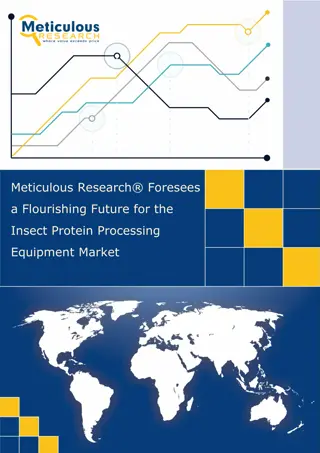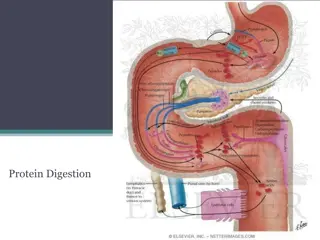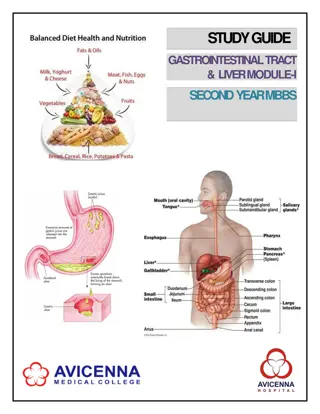Comprehensive Overview of Protein Digestion in the Gastrointestinal Tract
Understanding the process of protein digestion is crucial for optimal nutrient absorption and overall health. In this lecture series by Professor Shraddha Singh, delve into the composition of proteins, the role of enzymes in protein digestion, sites of absorption, molecular basis of protein transportation, and diseases related to protein digestion. Explore the structure of amino acids, the breakdown of proteins into peptides and amino acids, and the initial digestion of proteins in the stomach. Gain insights into the importance of essential and non-essential amino acids, dipeptides, tripeptides, and more in the intricate process of protein metabolism.
Download Presentation

Please find below an Image/Link to download the presentation.
The content on the website is provided AS IS for your information and personal use only. It may not be sold, licensed, or shared on other websites without obtaining consent from the author. Download presentation by click this link. If you encounter any issues during the download, it is possible that the publisher has removed the file from their server.
E N D
Presentation Transcript
Lecture series Gastrointestinal tract Professor Shraddha Singh, Department of Physiology, KGMU, Lucknow
Learning Objectives: Understand the composition of protein Understand the enzymes responsible for digestion of proteins What are sites for absorption Molecular basis of protein transportation Learn about diseases related to protein digestion
What are Protiens ? Proteins are a sequence of amino acids One amino acids is joined to the next by a PEPTIDE bond Provide energy substrate for metabolism (4 kcals/g). Protein load received by the gut is derived from two primary sources: 70-100 g dietary protein, and 35-200 g endogenous protein,
Amino acids Of the 20 amino acids that exist, 9 are essential amino acids, and 11 are non- essential
AMINO ACID: Sequence Dipeptide 2 amino acids Tripeptide 3 amino acids Oligopeptides 4-10 amino acids Polypeptide more than 10 amino acids Proteins in the body and diet are long polypeptides (100s of amino acids)
AMINO ACID: Sequence Dipeptide 2 amino acids Tripeptide 3 amino acids Oligopeptides 4-10 amino acids Polypeptide more than 10 amino acids Proteins in the body and diet are long polypeptides (100s of amino acids)
AMINO ACIDS: Structure Consist of a central carbon atom bonded to: a hydrogen, a carboxylic acid, an amino group, and an additional side group that is unique to each amino acid
Initial digestion of protein in stomach No digestion of protein takes place in the mouth, Hydrochloric acid denatures protein and also converts pepsinogen to pepsin Pepsin breaks the protein down into peptides of various lengths and some amino acids Pepsin act only at pH 1.6-3.2 Pepsin completes ~ 10-20% of digestion
Denaturing of Proteins Acid, alkaline, heat and alcohol, can disrupt the chemical forces that stabilize proteins and can cause them to lose their shape (denature) Denaturing of proteins happens during food preparation (cooking, whipping, adding acids) or digestion (in the stomach with hydrochloric acid)
Action of Proteolytic enzymes Pepsin hydrolyses the bonds between aromatic amino acids(phenylanine or tyrosine) and a second amino acid So the product of pepsin hydrolysis is polypeptides of diverse sizes
Polypeptidases Trypsinogen and chymotrypsinogen (proenzymes) are secreted by pancreas in response to protein in the small intestine They will be activated to trypsin and chymotrypsin (now called proteases)
Peptidases hydrolyse proteins These enzymes can either cleave internal peptide bonds (i.e. endopeptidases) exopeptidases cleave off one amino acid at a time from either the COOH or NH2 terminal of the polypeptide (i.e. they are carboxypeptidases , and aminopeptidases, respectively)
The endopeptidases cleave the large polypeptides to smaller oligopeptides, which can be acted upon by the exopeptidases to produce the final products of protein digestion, amino acids, di- and tripeptides, which are then absorbed by the enterocytes
Further hydrolysis by Peptidases By the action of endo and exopeptidases some free amino acids are liberated in the intestinal lumen, But others are liberated at the cell surface by the aminopeptidases, carboxypeptidases, endopeptidases, and dipeptidases in the brush border of the mucosal cells.
Transport of amino acids and polypeptides in the enterocytes The di- and tripeptides are actively transported into enterocytes by a system known as peptide transporter 1) that requires H + instead of Na +
At basolateral membrane The movement of any one amino acid can occur through one or more amino acid transporters. At least five amino acid transporters are present in the basolateral membrane. Three amino acid transport processes on the basolateral membrane mediate amino acid exit from the cell into the blood Two other amino acid transporters mediate uptake from the blood for the purposes of cell nutrition.
Amino acid transport at basolateral Individual amino acids are transported across the basolateral membrane without the need for cotransport. Many different amino acid transporters are located on the basolateral membrane and provide specificity
Further hydrolysis by Peptidases By the action of endo and exopeptidases some free amino acids are liberated in the intestinal lumen, But others are liberated at the cell surface by the aminopeptidases, carboxypeptidases, endopeptidases, and dipeptidases in the brush border of the mucosal cells.
Transport of amino acids and polypeptides in the enterocytes The di- and tripeptides are actively transported into enterocytes by a system known as peptide transporter 1) that requires H + instead of Na +
At basolateral membrane The movement of any one amino acid can occur through one or more amino acid transporters. At least five amino acid transporters are present in the basolateral membrane. Three amino acid transport processes on the basolateral membrane mediate amino acid exit from the cell into the blood Two other amino acid transporters mediate uptake from the blood for the purposes of cell nutrition.
Amino acid transport at basolateral Individual amino acids are transported across the basolateral membrane without the need for cotransport. Many different amino acid transporters are located on the basolateral membrane and provide specificity
Diseases associated with absorption of proteins Hartnup disease and cystinuria are hereditary disorders of amino acid transport across the apical membrane. These autosomal recessive disorders are associated with both small intestine and renal tubule abnormalities the absorption of neutral amino acids in the case of Hartnup disease and of cationic (i.e., basic) amino acids and cystine in the case of cystinuria.
References Lippincott s Illustrated Reviews: Physiology (2013) Medical Physiology, Updated second edition (walter F. Boron, MD, phd) Berne & levy, physiology, sixth edition, updated edition Ganong s Review of Medical Physiology, 26 t h e d i t i o n























